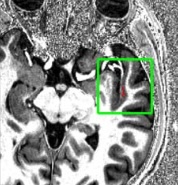Myelination imaging
Quantification of myelination
Updated: 2024-09-09
Gray matter myelination is an interesting tissue characteristic of a human brain, which may give us insights into cognitive and perceptual mechanisms.
What is intracortical myelination?
Myelin is a fat-like lipid-rich material wrapping around axons of neurons in the brain and spain, providing electrical insulation, just like the power cable–a copper wire wrapped around with rubber.
How do we image intracortical myelination?
We can do it with using PLI on a tissue slice. But we cannot do it non-invasively in 3-D. Still, we have a good magnetic resonance (MR) correlate with is a longitudinal relaxation time (T1), or its reciprocal (1/T1 = R1), a longitudinal relaxation rate. While there are other MR correlates of myelin than T1, and T1 reflects not only myelin but also other tissue contents such as iron.
Don’t we have diffusion-weighted imaging for myelination?
In diffusion-weighted imaging (DWI), the measure of fractional anisotropy (FA) of a fitted diffusion tensor is often interpreted as a correlate of axonal myelination. This assumes parallel axons in a voxel, thus the myelination of parallel axons would restrict water diffusion inside the axons as more anisotropic (i.e., more elliptical). This may be the case in certain white matter bundles, but not in the cortex.
Applications
Intracortical myelination and absolute pitch
In a between-subject design (Kim & Knösche, 2016), we found higher intracortical myelination (indicated by lower T1 values) in the right planum polare (the anterior part of the supratemporal plane) of musicians with absolute pitch than without. The higher intracortical myelination suggests a suppression of neural plasticity. Given the importance of the early onset of musical training in developing absolute pitch, the increased myelination could contribute to the preservation of the pitch chroma template that the absolute pitch listeners utilize.
Intracortical myelination and impulsivity
In a cross-sectional case-control study (Nord* et al., 2019), we found a premature responding (representing “waiting” impulsivity) in youth was associated with decreased myelination of the ventral region of the bilateral putamens. This finding is consistent with a study where high waiting impulsivity in rodents is characterized by lower ventral striatal D2/3 receptors (Dalley et al., 2007).
Intracortical myelination and alcohol resilience
Moreover, in a longitudinal study (Weidacker* et al., 2020), we found the baseline myelination of the bilateral anterior insular and subcallosal cingulate predicted a lower risk for harmful alcohol use at a 2-year follow-up.
Conclusions
Quantitative imaging including R1 mapping is essential to understand the microstructure of the human brain and their mechanical adaptations for various cognitive and affective functions.
References
2020
- The prediction of resilience to alcohol consumption in youths: insular and subcallosal cingulate myeloarchitecturePsychological Medicine, Nov 2020
2019
- The myeloarchitecture of impulsivity: premature responding in youth is associated with decreased myelination of ventral putamenNeuropsychopharmacology, Feb 2019

